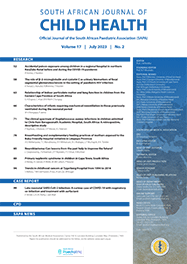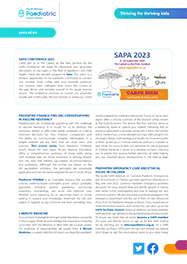Research

Feeding patterns of infants admitted with lower respiratory tract infections in an HIV-endemic area
Abstract
Background. Lower respiratory tract infections (LRTIs) remain a major cause of mortality and morbidity in infants in South Africa (SA). Exclusive breastfeeding has been shown to decrease mortality and morbidity in infants with LRTIs, especially in the context of HIV/AIDS. Major effort has been put into educating HIV-positive mothers on the benefits of exclusive breastfeeding within effective prevention of mother-to-child transmission (PMTCT) programmes.
Objectives. To determine the feeding practices among infants admitted with LRTIs in an HIV-endemic area.
Methodology. The study was a retrospective chart review of all infants admitted with a diagnosis of LRTI between 1 January 2015 and 31 December 2015 at King Edward VIII Hospital, Durban, SA. Data on feeding patterns, socioeconomic status, maternal HIV status and clinical outcomes of LRTI admissions were collected.
Results. Of the 308 infants enrolled, 63% were male. Exclusive breastfeeding rates of those aged <6 months with LRTIs were higher than those found in previous studies; however, these feeding patterns were significantly associated with the HIV status of the mother (p=0.003). Mothers who were HIV-negative were twice as likely to breastfeed as those who were HIV-positive (odds ratio 2.25; 95% confidence interval 1.32- 3.88). There was no association between the type of feeding and the clinical outcomes for LRTIs.
Conclusion. Maternal HIV status influenced the feeding patterns of infants admitted with LRTIs with lower exclusive breastfeeding rates in the HIV-exposed group. Despite extensive efforts to promote breastfeeding within effective PMTCT programmes, HIV-positive mothers are still not harnessing the benefits that exclusive breastfeeding provides.
Authors' affiliations
S Muhomud, Department of Paediatric and Child Health, Nelson R Mandela School of Medicine, Faculty of Health Sciences, University of KwaZulu-Natal, Durban, South Africa
K L Naidoo, Department of Paediatric and Child Health, Nelson R Mandela School of Medicine, Faculty of Health Sciences, University of KwaZulu-Natal, Durban, South Africa; Department of Paediatrics, King Edward VIII Hospital, Durban, South Africa
V Naidoo, Department of Paediatric and Child Health, Nelson R Mandela School of Medicine, Faculty of Health Sciences, University of KwaZulu-Natal, Durban, South Africa; Department of Paediatrics, King Edward VIII Hospital, Durban, South Africa
R Masekela, Department of Paediatric and Child Health, Nelson R Mandela School of Medicine, Faculty of Health Sciences, University of KwaZulu-Natal, Durban, South Africa
Full Text
Cite this article
Article History
Date published: 2018-12-14
Article Views
Full text views: 1187

.jpg)



Comments on this article
*Read our policy for posting comments here